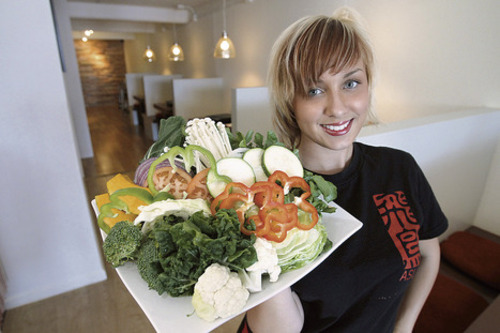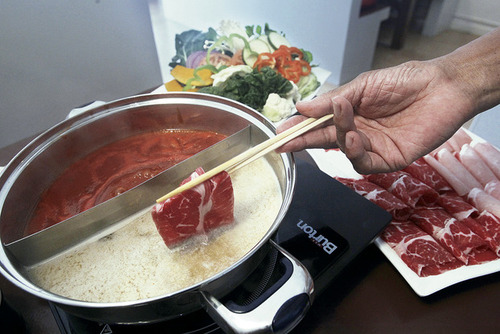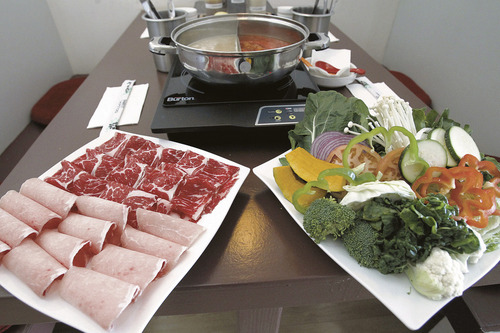As you probably know — but wish you didn’t — restaurant food usually astounds because of copious amounts of salt, fat and/or sugar (pick your vice). If you believe otherwise, you’re in denial. It is the rare and remarkable chef who opts to do with less of the bad stuff, making up the difference with herbs and spices.
Even then it’s a hard sell. People claim to want to eat better, but the typical strategy goes something like this: Given the choice of cheese-slathered pizzas, a big juicy burger or fat-oozing pork belly and a salad, people will get the bad stuff with a side salad and hope the good cancels the bad. Sorry, doesn’t work that way. I believe you eat the salad, filling up so there’s zero room for the bad stuff.
Because I eat out so much, I appreciate every opportunity to eat healthfully, but food still has to taste good, and the newly open Asuka Nabe + Shabu Shabu is up to the challenge.
Chef-owner Hitoshi "Kenny" Ikeguchi was a partner in another shabu shabu endeavor before opening this space, specializing in Nara-style Asuka nabe, dating back 1,300 years to a glorious period in Japan history marked by advancement in the arts, culture and politics.
I once complained that his first endeavor was too healthy, and following up, I asked him what he had learned from it. He said, "People like a lot of different sauces," meaning that though shabu shabu and nabe are intrinsically healthful — starting as a big bowl of soup with little salt or fat — they’ve been pumped up to taste good to our palates, and side sauces add more salt and fat to taste.
At Asuka you have both extremes to choose from, and a lot in between.
You can start with a choice of four traditional, basic soups: kombu (seaweed), wafu (seafood, soy sauce, mirin and sake), sukiyaki (sweet) or umakara (spicy). These are free when ordering a shabu shabu set of meat and vegetables.
Chances are, you’ll gravitate to the premium soup bases, where, at the extreme healthful end, there is an oolong tea soup base ($2.95). First time around, I ordered this, splitting the pot with the delicious Asuka namesake soup ($2.95) made from milk, miso, chicken broth with a bit of honey and accompanied by two pats of butter to add to the pot.
Looking at the pot, Ikeguchi, who’s always an observant presence in the room, said, "Ah, since I opened, I think I served 1,600 customers, and you are the fifth to order the oolong tea. And one complained, ‘This is just tea!’"
Even before it arrived, I was thinking I’d made a huge mistake. Part of the joy of shabu shabu is drinking the soup after everything is cooked, and I couldn’t imagine drinking tea in which beef and pork had been cooked. On the plus side for those so inclined, the specially imported mountain oolong is rich in antioxidants, but the downside was that by evening’s end the finished soup was quite bitter.
Similarly, the green pea and vegetable soup base is split green pea soup, and is great for vegetarians or anyone who wants to drink the soup, but the aesthetics aren’t so great when it starts foaming orange with the addition of shrimp, and when your tofu turns green. Try the Asuka base or pork-and-vegetable paitan ($2.95) before exploring the rest of the menu.
If you’re indecisive, you might want to start with the all-inclusive nabes, with their set combinations of broth, meat and vegetables for $18.95 to $24.95. An example is the niku dango nabe ($19.95) with its delicious namesake chicken-and-pork meatballs, boneless chicken wings, vegetables, enoki mushrooms, aburage, udon and tofu in a choice of wafu, umakara or tomato soup base.
You’ll probably end up paying more with the a la carte shabu shabu menu, where meat sets start at $16.95, and a basic set of vegetables, tofu, udon and single gyoza is included, but it’s hard to resist adding on more veggie, mushroom, seafood and noodles, at costs ranging from $2.95 for noodle or baked garlic, $5.95 for clams or $6.95 for New Zealand lamb or beef tongue.
I tend to like pork better than beef, but here the beef in a rib eye and pork loin platter ($24.95) was far more flavorful, and considering the $10 price difference between rib eye and Kobe wasyu-gyu, there wasn’t enough of a flavor and textural difference, once the beef was boiled, to make me order the Kobe again.
To add more flavor to your cooked food, those sauces that Ikeguchi offers include ginger, ponzu, sesame, soy and Sriracha, along with other condiments of salt and pepper, sesame seeds and togarashi to mix and match. Unfortunately, you’ll have to pay $1.95 for sesame oil.
I couldn’t choose among all the mushrooms offered, so simply went with the mixed mushroom plate that includes them all: shimeji, king, shiitake, oyster and enoki.
A set of vegetables, including choy sum, comes with the purchase of each shabu shabu set, but you might want to add onions ($2.95) or baby bok choy ($2.95). I tend to eat choy sum cooked at Chinese restaurants, but here it was great to eat it raw, wrapped around the cooked beef.
I didn’t try the yuba (bean curd), and the collagen on the menu isn’t available yet, but those give me something to look forward to on my next visit.
Dessert of Asuka ice cream ($4.95) was also not available, but if you still feel the need for dessert, there’s shave ice next door at Aloha Crepes.
Nadine Kam‘s restaurant reviews are conducted anonymously and paid for by the Star-Advertiser. Reach her at nkam@staradvertiser.com.








